Come take a look at what Aerocool has to offer in the wide world of Athlon cooling. The Deep Impact is just right for keeping your CPU temperatures in check.
Introduction
After looking over a few of Aerocools new fans, I was really anxious to start testing their new Deep Impact heat sink. The Deep Impact is a far step away from your average heat sink, touting 36 copper fins surrounding a superconductor tube for maximum cooling performance. I like to keep the hot spots of my PC cool, and a nice processor heatsink is one of the products that I use to achieve this goal. Lets see how the Deep Impact fares against my Athlon 2000+’s retail heatsink/fan.
WOW!!! This thing is huge!!! Those were my first thoughts when I opened up the Deep Impact DP-102 package. Standing at approximately 4 inches tall and weighing in at a stout 20.5oz, I was almost afraid to install it, fearing that it may flex my motherboard a little more than I would like.
 |
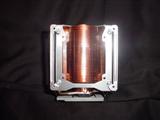 |
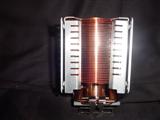 |
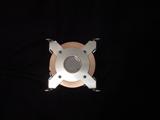 |
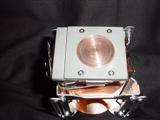 |
Features & Specs
Features:
- High thermal conductivity
- Full copper cooler with superconductor tube for max performance
- Super attractive “Round” shape cooler
- DP-102 offers “Dual Fan” solution – user can mount 1 or 2 fans on the cooler (Fan(s) not included in the package)
- Two sets of 70mm to 80mm fan adapters are included in the package
- The cooler can be rotated 360 degrees and fans can be mounted in any position
- DP-102 can be an “Universal” cooler compatible with both Intel P4 and AMD applications
Applications:
- Intel: P4 socket 478 3.6Ghz and higher (Only applies to the “Universal” version, not available for the AMD version)
- AMD: Athlon XP 3600+ and higher
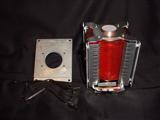 |
 |
- Heatsink
- Two sets of 70mm to 80mm adapters
- P4 and Athlon mounting hardware
- 8 installation screws
- Tube of thermal paste
- Instruction manual
Installation
The included instructions from Aerocool recommend attaching two fans facing each other to the Deep Impact for best results. I thought it was a little strange to suggest this idea instead of the more popular push and pull installation.
I ran into a few problems with the installation of this particular heatsink, which is never a good first impression. First, I removed my power supply from my case, which is a step that others may be able to skip, as I use a small mid-tower ATX case that places the power supply very close to the motherboard. I do not blame this on the Deep Impact, because I have to remove the PSU to install other products as well. I secured my Aerocool Storm Juggler to the front side of the heatsink using the supplied 80mm fan adapters so that I could control the fan speed to obtain an optimal cooling to noise ratio if need be. After I applied the supplied thermal paste to the CPU die, I began to place the heatsink and fan on the processor, but noticed that it was not sitting flush. After some looking around I found my problem. The 80mm fan was sitting on two motherboard capacitors. Doh! I tried placing the fan on the rear of the heatsink so that it was in an air pulling position, but this also resulted in the fan sitting on capacitors. After some searching, I came across my stock 60mm AMD heatsink fan and attached it to the front of the heatsink. This arrangement was not my ideal solution, but that is the way it goes.
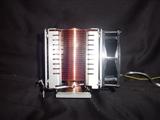 |
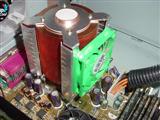 |
 |
Performance
Seeing as this is a heatsink review, I might as well toss some numbers up for you to take a look at. I will show both idle and load temperatures for the Deep Impact with a stock AMD fan and a Thermaltake Volcano 11 with an Aerocool Storm Juggler at 3500RPM. To heat up the processor, I ran Folding@Home for 20 minutes on each heatsink. The stock AMD fan creates quite a racket when it is spinning unbridled at around 5500RPM. This noise can get quite annoying pretty fast, which is one reason many people opt for aftermarket cooling solutions. Folding can run the CPU at 100% when it is not being utilized by other applications and is also a great way of working towards something good. I used Winbonds Hardware Doctor to measure the CPU temperature for this review. Hardware Doctor uses the Abit thermal sensor that is located just under the CPU die to get an accurate temperature reading.
System Specs:
- Abit KR7A-133R
- Athlon XP 2000+
- 768MB DDR 2100
- BFG GeForce FX 5950 Ultra
- 80GB IBM Deskstar
- 120GB Maxtor
- Lite-On 4xDVD+-RW
- TDK 40/12/40 CD-RW
- Antec 350W PSU
- Windows XP SP1
Folding@Home
|
||||||||||||||||||||||||||||||
As you can see, the Deep Impact and the Volcano both perform better than the stock unit does when idle. When things start to heat up however, the Aerocool comes within about 1.5C of the stock AMD cooler. This small variance may be acceptable for the average gamer like me, but I would be leery to recommend this product to someone who was planning on doing any overclocking. Since I am stuck with a Palomino core, my over-clocking is almost fruitless, as I have only been able to muster around 200MHz from my 2000+. Other users may have better results than I saw, since other motherboard layouts may allow for a dual fan installation, which will obviously allow for more airflow.
Final Thoughts
Pros:
- Cools better than stock
- Additional fans add flexibility and variety
- Original and flashy design
Cons:
- Huge…very huge
- Heavy….quite heavy
Other than the installation problems that I ran into, with the fan resting on capacitors, I was pretty impressed with the overall outcome of the Deep Impact. Keeping your processor cool at all times is something that I highly recommend, as it can help to extend the lifetime of your CPU, and the Deep Impact did just that for me. If you are an over clocker trying to squeeze every last cycle out of your processor, you may want to look elsewhere, as the Deep Impact may not be able to keep your CPU as chilly as you would like.
 Bjorn3D.com Bjorn3d.com – Satisfying Your Daily Tech Cravings Since 1996
Bjorn3D.com Bjorn3d.com – Satisfying Your Daily Tech Cravings Since 1996



